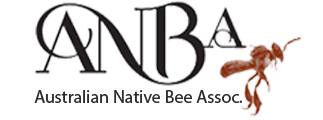Dean Haley, Chair of the ANBA Honey Subcommittee, Email: josephhale67@gmail.com
The honey from our native bees has been a much-loved part of our Australian culture for thousands of years. Our bees were protected and used sustainably within the boundaries of the various totem systems throughout Aboriginal Australia. The honey from our native bees was available to all levels of society and was a prized food.
Honey was seen as bush medicine in many parts of Australia, where it was viewed as a clean and nourishing food, with antimicrobial properties used to treat skin conditions, and sometimes used as eye drops.
The honey of native bees was also enjoyed by the English colonists. Newspapers as early as 1803 rave about the taste. They were valued so much, that living colonies of Tetragonula carbonaria bees were shipped to England and France. Few survived the long sea voyages and none of them survived the European winters.
And then, in 1822 European Honey Bees were introduced to Australia. These bees could produce large volumes of honey, and had an instant liking for our Eucalyptus trees. Suddenly people had large volumes of fairly cheap, very sweet honey available. The early love affair with our native bees cooled, and the bees were largely forgotten.
For the next two hundred years the native bee honey was enjoyed by a fraction of Australian society, including Aboriginal and Torres Strait Islanders, native bee keepers, and “bushies” such as timber cutters. The Food Standards of Australia/New Zealand ignored our bees, as there were so few people enjoying the limited quantities of native honey and created Standard 2.8.2 Honey, which refers only to honey bees.
In the last 30 years or so, a niche market has emerged with chefs using our honey. The introduction of modern native bee-keeping boxes has allowed for relatively non destructive honey harvesting. It is time for our native honey to leave the shadows and be appreciated.
The ANBA has promoted our honey in various ways. We have enabled scientific studies on the health benefits with funding from Agrifutures and also the ANBA. ProfMary Fletcher and team from University of QLD/ QAAFI have studied the antioxidant, low glycaemic sugar, trehalulose, found as approximately 20% of our honey. The ANBA submitted an application to Food Standards Australia New Zealand to have our honey recognised as a standardised food. The application was accepted in July 2022, and the approval process will start in late July 2023. If all goes to plan, the FSANZ timeline should approve our native bee honey by the middle of 2024.
Recognising our honey with a food standard will help our honey producers in a variety of ways.
•It shall remove any confusion where it does not meet the existing honey standard 2.8.2
•It shall create awareness for Australian and New Zealand consumers
•Reassure consumers it has been assessed for food safety concerns
•Create new marketing opportunities, including export markets
The ANBA has also sponsored prizes for native bee honey at the NSW Royal Easter show, and the QLD Ekka show. The judging, and judges’ comments will create new ways to appreciate and understand the flavour profiles and quality aspects of our honey. The native bee honey judging at the Ekka show this year is on Saturday 5th August 2023.
Talking of flavour aspects, Dr Natasha Hungerford, with funding from Agrifutures & ANBA has published a paper (Hungerford et al, 2023) on the organic acid profiles found in carbonaria, hockingsi, davenporti, and australis honey. This research increases our understanding of the physicochemical parameters of the native bee honey, and may help us create fingerprints to verify that native bee honey in the marketplace is authentic.
Exciting research being conducted includes University of Western Australia’s (Dr Connie Locher, Honey research laboratory, Division of Pharmacy) research into trehalulose quantification, and identification fingerprints. The bee-lab at The University of Sydney is investigating anti-microbial properties of stingless bee honey, under the watchful eyes of Drs Ros Gloag & Dee Carter.
References:
Fletcher, M.T., Hungerford, N.L., Webber, D. et al. Stingless bee honey, a novel source of trehalulose: a biologically active disaccharide with health benefits. Sci Rep 10, 12128 (2020).
Natasha L. Hungerford, Hans S.A. Yates, Tobias J. Smith, Mary T. Fletcher, Organic acid profiles of Australian stingless bee honey samples determined by ion chro-matography., Journal of Food Composition and Analy-sis, Volume 122, 2023.
